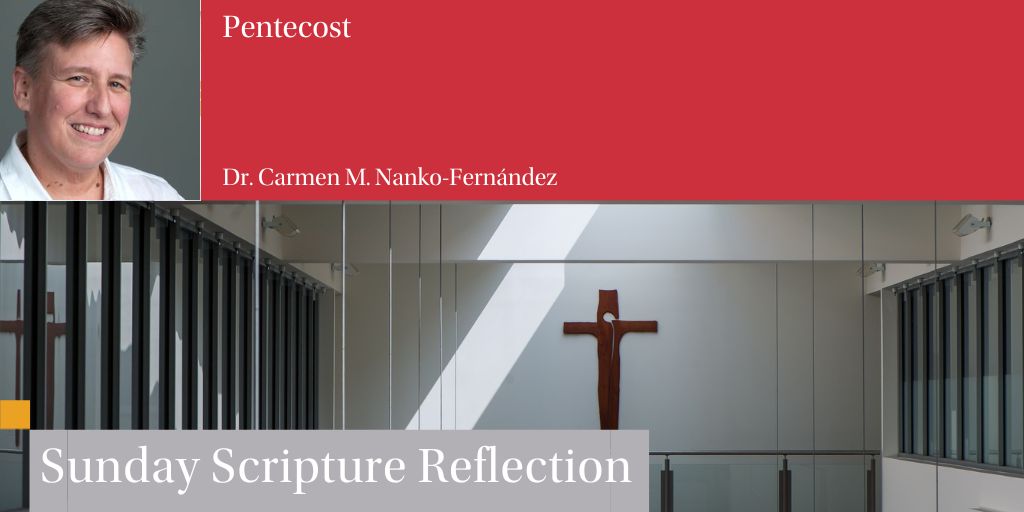

Readings:
Acts 2:1-11
Psalm 104:1, 24, 29-30, 31, 34
1 Corinthians 12:3b-7, 12-13
John 20:19-23
The past fifty days have been disorienting in so many ways. Fifty days ago this Sunday, as church, we celebrated Easter and the unexpected public appearance of Pope Francis. Though his frailty prevented him from delivering his Urbi et Orbi message in his own voice, we took comfort in hearing and receiving his Easter greeting and blessing from the loggia of St. Peter’s Basilica. His subsequent surprise emergence in the popemobile elicited cries of “viva il papa,” long live the pope, from the cheering crowds who were witnessing what turned out to be his last circuit of the plaza.
Less than 24 hours later, people of faith and good will were overcome by grief, though grateful for that gift of one more day with Francis. The church entered an ambiguous time, a state of sede vacante, an interregnum period marked by mourning and preparation yet filled with endless speculation, contested memories, conflicting aspirations, and even a few attempts to consolidate power. Trusting that a conclave would be guided by the Spirit, and with cautious anticipation, we greeted our 267th pope, Leo XIV, (Robert Prevost, OSA, CTU Class of 1982) on that very same loggia exactly one month prior to this Pentecost Sunday.
Having survived slightly over two weeks of papal vacancy, followed by a whirlwind of emotions and activity, many Catholics can empathize with the instinct of the disciples to hide in the upper room following the death of Jesus and its aftermath. How do we re-orient as people and communities of faith in order to move forward, especially in complicated global circumstances? In times of interruption, it is a good practice to return to our stories, the narratives that nurtured our identity and animated our hope across generations. The readings for Pentecost offer direction as we journey together—pilgrims of hope in a Holy Year begun under one Pope and to be continued under another.
The Acts of the Apostles, some agree, might more appropriately be named the Gospel of the Holy Spirit, whose works and presence are recounted throughout the book. Through the ministrations of the Spirit, the Galileans are empowered to leave the security of the upper room and hit the streets, able to communicate the “mighty acts of God” in a manner that allowed each listener to understand “in their own language.” The lectionary stops shy of reporting the fuller reaction of the crowd. While all are amazed and bewildered, some ask a relevant question “What does this mean?” Others derisively suggest perhaps a bit too much “new wine” is involved, a charge Peter denies: “These people are not drunk, as you suppose, for it is only nine o’clock in the morning” (Acts 2: 12-15).
Peter instead channels the prophet Joel, attributing the phenomena of proclamation and reception to the pouring out of the spirit which inspires: “Your sons and your daughters shall prophesy, your young shall see visions, your elders shall dream dreams” (Acts 2:17, Joel 3:1). It is a dream born in cultural and linguistic diversity, at the prompting of a Spirit unafraid of difference at the crossroads.
In his first letter to the Corinthians, Paul insists that it is the same Spirit who is at the heart of the different gifts and services that enhance the entire community. These differences should not be sources of division because diversity is not only a necessary condition for the functionality of communal life, it is God-given. Paul draws on the human body as metaphor for a community made one in Christ. Here again, each individual, each charism, each ministry contributes to the whole. In the words of the Catechism, “The body’s unity does not do away with the diversity of its members” (791).
“What does this mean?” is an ongoing question within the church. The dreamers at Vatican II explained that communicating in “language intelligible to each generation” required “scrutinizing the signs of the times and of interpreting them in the light of the Gospel” (Gaudium et spes, #4). In this particular age such scrutiny of the signs indicate attempts to cancel diversity, from draconian and cruel actions aimed at immigrants to costly punishments enacted against institutions and organizations who dare celebrate and insure its existence. Pentecost reminds us that lived experiences of diversity are expressions of divine intention.
From the moment the Spirit blew open the doors of the upper room, through the conclave, through the adventures of synodality, as church we continue to witness the Spirit urging us forward. On May 8, a new pope stepped forth and greeted those gathered, physically and virtually, in St. Peter’s Square. “La pace sia con tutti voi!” “Peace be with you all,” Leo XIV proclaimed; the words of the risen Jesus in today’s gospel, the best possible hope in the presence of diversity.
Carmen M. Nanko-Fernández is professor of Hispanic theology and ministry and director of the Hispanic Theology and Ministry Program at the Catholic Theological Union in Chicago.